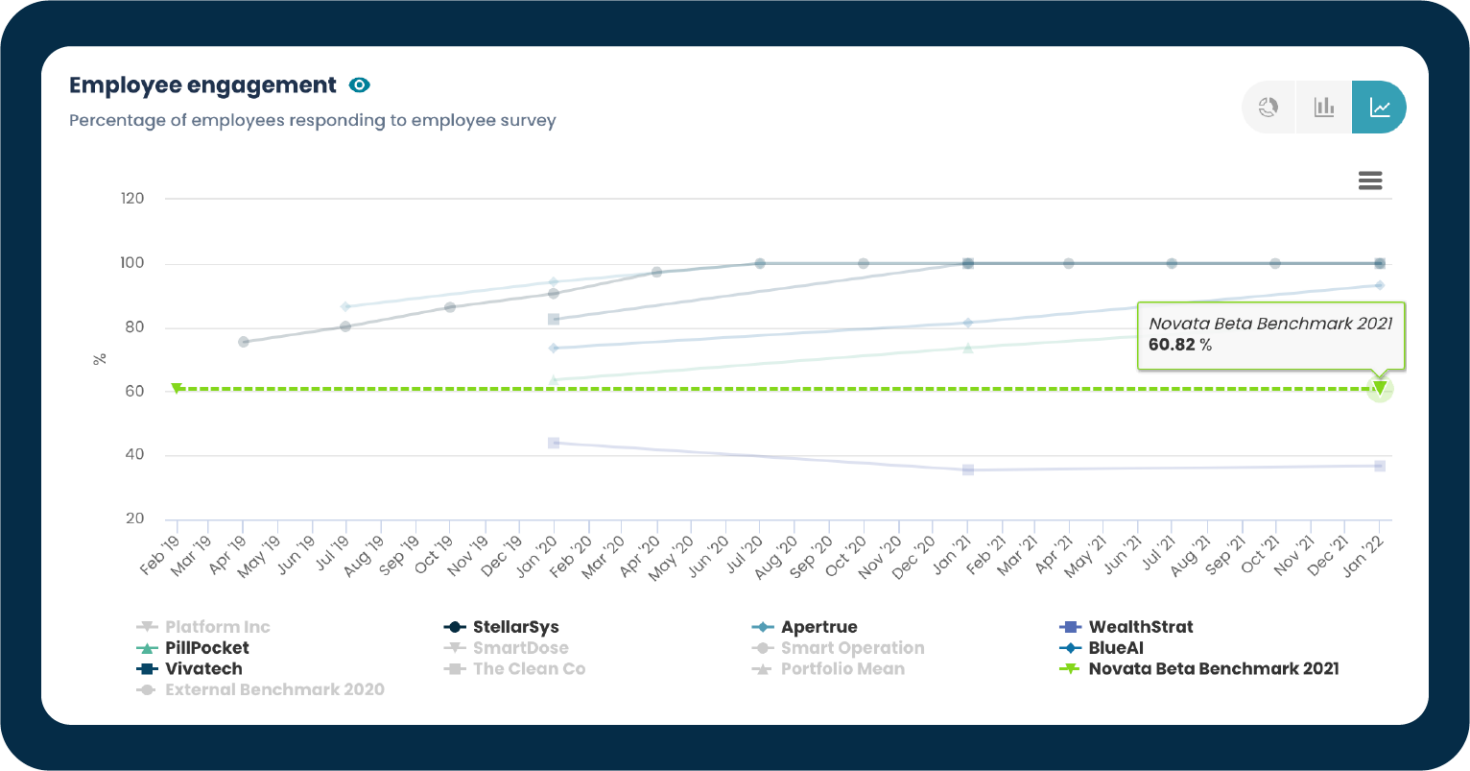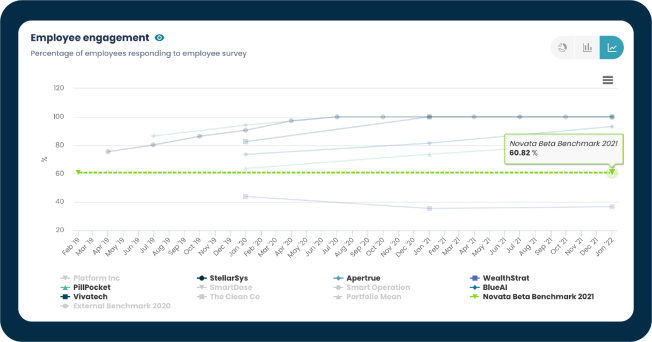Home
Definitions and Disclosures

There’s no easy solution to the first challenge on our list (LP views on which ESG factors are important to them will always vary), but there’s no excuse for this asset class to be held back by the remaining challenges. They are logistical issues that can be solved by process and technology.
And there are solutions out there. Groups like Novata have reduced barriers to collect, aggregate and benchmark data. Forward-thinking GPs have embraced the platform as a way to streamline their ESG processes and to quickly identify drivers of key ESG metrics across their funds.
This is the kind of progress that will make ESG standards measurable and something against which LPs and GPs can take action.
Still think it’s too hard? Novata reports that, on average, 81% of portfolio company data points requested by GPs through its platform are fulfilled. And those data requests take an average of only seven days for the portfolio company to complete. In a way, the path to better ESG reporting feels simple: All you need to do is ask your companies for the data and voila! (The platform even includes robust guidance, minimizing the need for you to explain what’s required to report to your companies.)
You’ve heard this refrain from us time and time again: Enough of the anecdotes that permeate this industry. Invest in data collection and analytics. Use it, work with it, benchmark yourself against it. The tools to do so are out there. Talk is cheap. Actionable data analysis is not.

The most commonly-requested metrics are an even mix of environmental and social KPIs. Emissions data tops the chart and occupies three of the top four positions. Surprising to any of you? This isn’t anecdotal; this is real data.
Novata aggregates data from the thousands of companies on its platform to create benchmarks that allow managers and asset owners to compare ESG data anonymously to industry peers.
Want to know how a portfolio company’s emissions, board diversity, or employee engagement compares to industry peers? That data is now available.
- Scope 2 emissions
- Scope 1 emissions
- Days lost due to injury
- Scope 3 emissions
- Number of work-related fatalities
- Total net new hires, FTE
- Organic net new hires, FTE
- % of total energy consumed that is renewable energy
- Number of work-related injuries
- Annual percent attrition
The top 10 most requested metrics by gps, appearing in 75% or more requests, are:
Look at the percentage of RFPs that feature ESG-related questions. They’ve crossed over the 50% threshold and we suspect that trend will continue to rise. When we break it down geographically, it’s not surprising that, in Western Europe, the figure is closer to 80%, with the U.S. and Asia trending closer to 40%.
This is not to say that all of the questions focused on the same things. ESG means different things to different LPs. Questions around DEI dominate in North America, with over half of RFPs asking for information on that topic. European LPs, on the other hand, most commonly ask about climate policies and emission data.
The irony here is that, while everyone (including us) is quick to bash general partners for any number of things, the industry has decided to make them the repository for all the confusion around what ESG is and how to measure it. Here, LPs say, give us information on a variety of different and competing goals and do it with no idea how much of it really matters to us. Oh, and do it quickly. (This is no trivial matter. In the 12 months ended June 30, 2022, Hamilton Lane responded to more than 2,000 ESG-related questions in RFPs and DDQs. 2,000! That’s like being asked six questions about ESG each and every day, including weekends and holidays….)
Let’s do another reality check. Everyone (GPs and LPs) likes to talk about how robust their ESG policies and reporting are, but few organizations are doing it well. Think about the interest in emissions tracking we highlighted earlier. Well, data from our GP survey shows that 79% of GPs are not capturing emissions data for the majority of their portfolio holdings.
Yikes!
If we compare the development of ESG tracking and reporting to the development of computers, we are probably closer to the abacus than we are to the device you’re reading this on today. There are plenty of legitimate reasons why this is the case:
- Differing, and sometimes competing, views on which ESG metrics are “most important.” That means GPs must track a huge number of factors to be responsive to LPs. There is naturally a lag between the time a new metric is requested and when it can be effectively tracked.
- Hesitancy to challenge portfolio companies to implement tracking and provide metrics.
- Lack of systems to organize and track data. If spreadsheets aren’t good enough for tracking your financial data, they’re not good enough for tracking your ESG data either.
- Lack of sufficient context or benchmarks. Even when data is readily available, it’s difficult for stakeholders to know what constitutes a “good” number. We recently provided emissions data for the private equity portfolio of a large pension to their board. The board’s response: “Great, but what do I do with this number? Is it good? Should it be better?”
Here’s another shameless plug.
Hamilton Lane is a strategic investor in a public benefit corporation called Novata, which facilitates sharing of ESG data between GPs and their portfolio companies. Companies like Novata are leading the way to ensuring that ESG reporting will advance beyond the happy talk stage. What do we know already from the data Novata is tracking? For starters, the data suggests that GPs, on average, request 30 ESG metrics from their portfolio companies.
RFPs CONTAINING ESG QUESTIONS
Overall LP Focus
We have been reviewing a greater number of RFPs and DDQs every year. 2023 set a record, with nearly 400 documents reviewed, and 2022 is on pace to be another big year, although slightly down from the record.
ESG
ESG is not about “woke” investing; it is about evaluating real investment risks – consider the impact that rising seas might have on ports and the knock-on effect that will have on global logistics and supply chains – and ensuring responsible governance structures and hiring practices in an industry where returns are built on superior governance and attracting top talent. We should all want the same things here.

View our 2022 Market Overview Highlights
hamiltonlane.com



WHAT WE OFFER
ABOUT US
FIRM UPDATES
Our Team
HL Innovations
News
Insights
Product Solutions
Private Wealth Solutions
Digital Solutions
ESG and Responsible Investing
< 2023 Market Overview Home
Definitions and Disclosures


The most commonly-requested metrics are an even mix of environmental and social KPIs. Emissions data tops the chart and occupies three of the top four positions. Surprising to any of you? This isn’t anecdotal; this is real data.
Novata aggregates data from the thousands of companies on its platform to create benchmarks that allow managers and asset owners to compare ESG data anonymously to industry peers.
Want to know how a portfolio company’s emissions, board diversity, or employee engagement compares to industry peers? That data is now available.
- Scope 2 emissions
- Scope 1 emissions
- Days lost due to injury
- Scope 3 emissions
- Number of work-related fatalities
- Total net new hires, FTE
- Organic net new hires, FTE
- % of total energy consumed that is renewable energy
- Number of work-related injuries
- Annual percent attrition
The top 10 most requested metrics by gps, appearing in 75% or more requests, are:
Look at the percentage of RFPs that feature ESG-related questions. They’ve crossed over the 50% threshold and we suspect that trend will continue to rise. When we break it down geographically, it’s not surprising that, in Western Europe, the figure is closer to 80%, with the U.S. and Asia trending closer to 40%.
This is not to say that all of the questions focused on the same things. ESG means different things to different LPs. Questions around DEI dominate in North America, with over half of RFPs asking for information on that topic. European LPs, on the other hand, most commonly ask about climate policies and emission data.
The irony here is that, while everyone (including us) is quick to bash general partners for any number of things, the industry has decided to make them the repository for all the confusion around what ESG is and how to measure it. Here, LPs say, give us information on a variety of different and competing goals and do it with no idea how much of it really matters to us. Oh, and do it quickly. (This is no trivial matter. In the 12 months ended June 30, 2022, Hamilton Lane responded to more than 2,000 ESG-related questions in RFPs and DDQs. 2,000! That’s like being asked six questions about ESG each and every day, including weekends and holidays….)
Let’s do another reality check. Everyone (GPs and LPs) likes to talk about how robust their ESG policies and reporting are, but few organizations are doing it well. Think about the interest in emissions tracking we highlighted earlier. Well, data from our GP survey shows that 79% of GPs are not capturing emissions data for the majority of their portfolio holdings.
Yikes!
If we compare the development of ESG tracking and reporting to the development of computers, we are probably closer to the abacus than we are to the device you’re reading this on today. There are plenty of legitimate reasons why this is the case:
- Differing, and sometimes competing, views on which ESG metrics are “most important.” That means GPs must track a huge number of factors to be responsive to LPs. There is naturally a lag between the time a new metric is requested and when it can be effectively tracked.
- Hesitancy to challenge portfolio companies to implement tracking and provide metrics.
- Lack of systems to organize and track data. If spreadsheets aren’t good enough for tracking your financial data, they’re not good enough for tracking your ESG data either.
- Lack of sufficient context or benchmarks. Even when data is readily available, it’s difficult for stakeholders to know what constitutes a “good” number. We recently provided emissions data for the private equity portfolio of a large pension to their board. The board’s response: “Great, but what do I do with this number? Is it good? Should it be better?”
Here’s another shameless plug.
Hamilton Lane is a strategic investor in a public benefit corporation called Novata, which facilitates sharing of ESG data between GPs and their portfolio companies. Companies like Novata are leading the way to ensuring that ESG reporting will advance beyond the happy talk stage. What do we know already from the data Novata is tracking? For starters, the data suggests that GPs, on average, request 30 ESG metrics from their portfolio companies.
There’s no easy solution to the first challenge on our list (LP views on which ESG factors are important to them will always vary), but there’s no excuse for this asset class to be held back by the remaining challenges. They are logistical issues that can be solved by process and technology.
And there are solutions out there. Groups like Novata have reduced barriers to collect, aggregate and benchmark data. Forward-thinking GPs have embraced the platform as a way to streamline their ESG processes and to quickly identify drivers of key ESG metrics across their funds.
This is the kind of progress that will make ESG standards measurable and something against which LPs and GPs can take action.
Still think it’s too hard? Novata reports that, on average, 81% of portfolio company data points requested by GPs through its platform are fulfilled. And those data requests take an average of only seven days for the portfolio company to complete. In a way, the path to better ESG reporting feels simple: All you need to do is ask your companies for the data and voila! (The platform even includes robust guidance, minimizing the need for you to explain what’s required to report to your companies.)
You’ve heard this refrain from us time and time again: Enough of the anecdotes that permeate this industry. Invest in data collection and analytics. Use it, work with it, benchmark yourself against it. The tools to do so are out there. Talk is cheap. Actionable data analysis is not.
ESG
RFPs CONTAINING ESG QUESTIONS
Overall LP Focus
We have been reviewing a greater number of RFPs and DDQs every year. 2023 set a record, with nearly 400 documents reviewed, and 2022 is on pace to be another big year, although slightly down from the record.
ESG is not about “woke” investing; it is about evaluating real investment risks – consider the impact that rising seas might have on ports and the knock-on effect that will have on global logistics and supply chains – and ensuring responsible governance structures and hiring practices in an industry where returns are built on superior governance and attracting top talent. We should all want the same things here.

View our 2022 Market Overview Highlights
hamiltonlane.com
Digital Solutions
ESG and Responsible Investing
Private Wealth Solutions
Product Solutions
Insights
News
HL Innovations
Our Team
WHAT WE OFFER
FIRM UPDATES
ABOUT US


